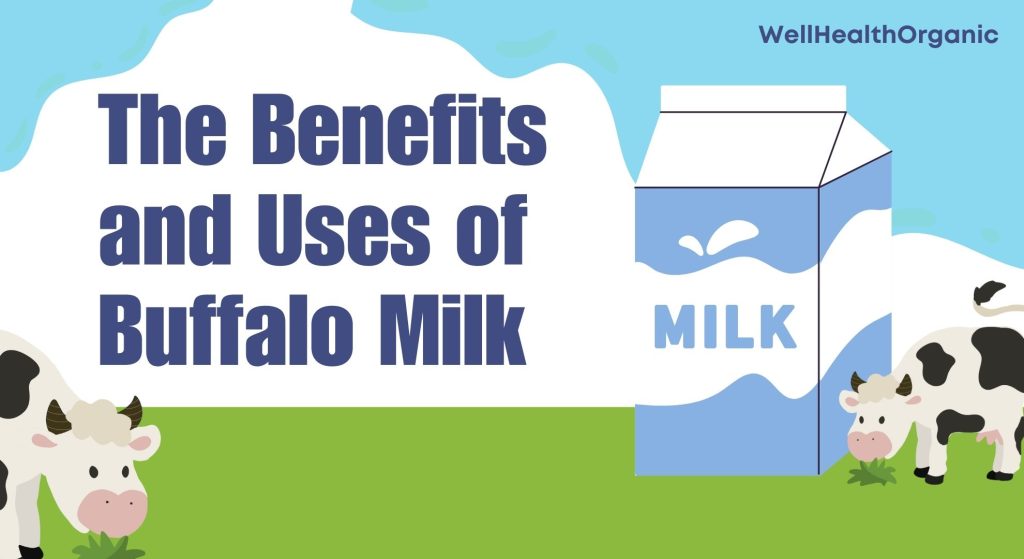Introduction
Buffalo milk is a nutrient-rich alternative to cow’s milk, widely consumed in various parts of the world. Known for its creamy texture and high-fat content, buffalo milk offers a range of health benefits that make it a popular choice for dairy lovers. This article explores the benefits, nutritional content, and various uses of buffalo milk, providing a detailed look at why it might be worth incorporating into your diet.
What is Buffalo Milk?
Buffalo milk comes from domesticated water buffaloes, primarily found in Asia and parts of Europe. Unlike cow’s milk, buffalo milk is thicker and creamier due to its higher fat content. It has been a staple in many cultures for centuries, used in everything from drinking milk to making cheese and yogurt. The rich taste and texture of buffalo milk make it a favorite for dairy products like mozzarella cheese, which is traditionally made from buffalo milk.
Buffalo milk is also known for its unique nutritional profile. It contains more protein, fat, and lactose than cow’s milk, making it a more calorie-dense option. Despite its richness, buffalo milk is often easier to digest for people who are sensitive to cow’s milk, as it has lower cholesterol levels.
What Are the Nutritional Benefits of Buffalo Milk?
Buffalo milk is packed with essential nutrients that contribute to overall health. It is an excellent source of calcium, which is crucial for maintaining strong bones and teeth. The higher fat content in buffalo milk means it also provides more energy, making it an ideal choice for those needing an energy boost.
In addition to calcium, buffalo milk is rich in protein, which is vital for muscle repair and growth. It also contains essential vitamins like A and D, which support immune function and bone health. The higher levels of antioxidants in buffalo milk help fight free radicals, potentially reducing the risk of chronic diseases.
Buffalo milk is also known for its lower cholesterol content compared to cow’s milk. This makes it a healthier option for people with cholesterol concerns. Additionally, the presence of bioactive peptides in buffalo milk has been linked to various health benefits, including antimicrobial and anti-inflammatory effects.
How Does Buffalo Milk Compare to Cow’s Milk?
When comparing buffalo milk to cow’s milk, the differences are quite noticeable. Buffalo milk has a higher fat content, which gives it a creamier texture and richer taste. This makes it ideal for making dairy products like butter, ghee, and cheese. In contrast, cow’s milk is lighter and more watery, which some people prefer for drinking.
Nutritionally, buffalo milk contains more protein, calcium, and phosphorus than cow’s milk, making it more nutrient-dense. On the downside, the higher calorie content of buffalo milk may not be suitable for those on a low-calorie diet. Buffalo milk also contains more lactose, which could be an issue for people with lactose intolerance.
Despite these differences, both types of milk have their own set of advantages. The choice between buffalo milk and cow’s milk often comes down to personal preference and dietary needs. For those seeking a richer taste and higher nutritional value, buffalo milk is an excellent choice.
Comparing Buffalo Milk and Cow’s Milk
| Nutrient/Property | Buffalo Milk | Cow’s Milk |
|---|---|---|
| Fat Content | Higher | Lower |
| Protein Content | Higher | Lower |
| Calcium | Higher | Lower |
| Cholesterol | Lower | Higher |
| Lactose | Higher | Lower |
| Texture | Creamier and thicker | Lighter and more watery |
| Best Uses | Cheese, butter, ghee, yogurt | Drinking, light dairy products |
What Are the Health Benefits of Consuming Buffalo Milk?
Consuming buffalo milk can provide several health benefits. Its high calcium content supports bone and dental health, making it especially beneficial for children and the elderly. The rich protein content aids in muscle repair and growth, which is crucial for athletes and those recovering from injuries.
Buffalo milk is also an excellent source of energy due to its high-fat content. This makes it an ideal choice for individuals needing extra calories, such as bodybuilders or people recovering from illness. Additionally, the presence of vitamin A in buffalo milk supports vision health and immune function, while vitamin D aids in calcium absorption, further benefiting bone health.
Another significant health benefit of buffalo milk is its lower cholesterol content. This makes it a heart-healthy option compared to cow’s milk. The antioxidants present in buffalo milk help reduce oxidative stress in the body, which can lower the risk of chronic diseases like heart disease and cancer.
How is Buffalo Milk Used in Cooking and Dairy Products?
Buffalo milk’s rich and creamy texture makes it ideal for various culinary uses. It is particularly popular in making dairy products such as mozzarella cheese, which is traditionally made from buffalo milk. The higher fat content in buffalo milk gives mozzarella its characteristic creaminess and stretchability.
In addition to cheese, buffalo milk is also used to make other dairy products like yogurt, butter, and ghee. The thicker consistency of buffalo milk yogurt makes it a favorite in many cultures, often used in desserts and savory dishes. Buffalo milk butter and ghee are prized for their rich flavor, making them popular in cooking and baking.
Buffalo milk can also be used in making sweets and desserts. In many parts of the world, buffalo milk is the preferred choice for making traditional sweets like kulfi and rasgulla. Its rich taste enhances the flavor of these delicacies, making them more indulgent and satisfying.
What Are the Potential Drawbacks of Buffalo Milk?
While buffalo milk has many benefits, there are some potential drawbacks to consider. The higher fat content, while providing energy and flavor, also means more calories. This could be a concern for individuals trying to manage their weight or reduce their calorie intake.
Buffalo milk also contains more lactose than cow’s milk, which can be problematic for people with lactose intolerance. The increased lactose content may lead to digestive issues like bloating, gas, and diarrhea in sensitive individuals. For those with lactose intolerance, it might be better to opt for lactose-free milk or plant-based alternatives.
Another potential drawback is the availability of buffalo milk. In some regions, buffalo milk may be harder to find than cow’s milk, making it less convenient for daily use. Additionally, buffalo milk is often more expensive due to its rich nutrient content and the costs associated with its production.
Buffalo Milk Benefits
Buffalo milk is a nutrient-rich dairy option with several health benefits, making it a valuable addition to your diet. Whether you’re looking to boost your calcium intake, support muscle growth, or enjoy richer dairy products, buffalo milk offers a range of advantages. While it has some drawbacks, such as higher calorie content and lactose levels, the benefits often outweigh these concerns. If you have access to buffalo milk and enjoy its creamy texture, it can be a delicious and nutritious alternative to cow’s milk.



